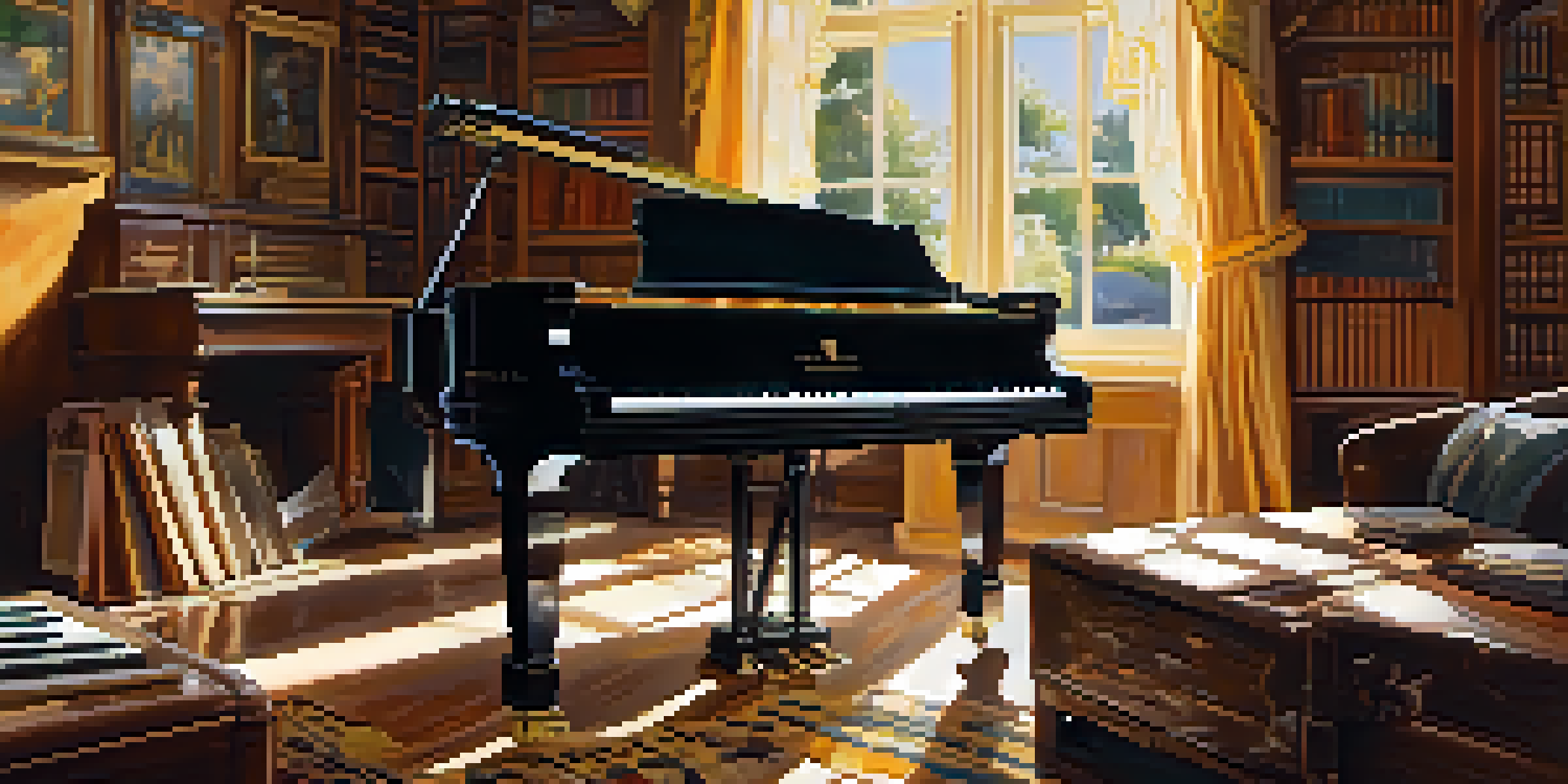Using Motifs: Creating Recurring Themes in Your Music

What Are Motifs and Why Do They Matter in Music?
Motifs are small musical ideas or phrases that recur throughout a piece. Think of them as the catchy hooks in your favorite songs that draw you in. They can be melodic, rhythmic, or even harmonic, and they play a crucial role in defining the character of your music.
Music is the shorthand of emotion.
By incorporating motifs, you create familiarity, allowing listeners to connect with your piece on a deeper level. Just like a memorable line in a movie, a well-placed motif can evoke emotions and trigger memories. This connection often leads to a more engaging listening experience.
Moreover, motifs help to unify your composition. When listeners hear the same motif reappear, it creates a sense of cohesion, making your music feel more structured and intentional. This can be especially important in longer compositions where the narrative needs to be maintained.
Identifying Your Unique Motifs: A Creative Approach
Finding your unique motifs starts with experimentation. Grab your instrument and let your creativity flow—play around with different notes, rhythms, and patterns until something resonates with you. This process is akin to a painter mixing colors to find the perfect shade.

Once you stumble upon a motif that excites you, play it in various contexts. Try changing the tempo or key, or even harmonizing it differently. This exploration not only helps solidify the motif in your mind but also reveals its versatility and potential.
Motifs Create Musical Connection
Motifs serve as recurring musical ideas that foster familiarity and emotional connections with listeners.
Remember, your motifs should reflect your musical identity. Think about what emotions or themes you want to convey in your music. Just as an author develops a unique voice, your motifs can become a signature part of your sound, making your music instantly recognizable.
Integrating Motifs Throughout Your Composition
Once you have a few motifs, the next step is to weave them into your composition. Start by introducing your motifs at key moments, ensuring they stand out to the listener. This could be during a chorus or a climactic point in your piece, much like introducing a beloved character in a story.
A motif is a musical idea that is used as a building block for a composition, providing unity and structure.
As you progress, consider varying your motifs to keep the listener engaged. You can change their dynamics, rhythm, or even the accompanying instrumentation. This variation is similar to a storyteller adding twists and turns to maintain interest in the plot.
Ultimately, the goal is to create a dialogue between your motifs. They should interact in ways that enhance the overall narrative of your piece, allowing for emotional build-up and resolution. This interplay can transform your music from a simple arrangement into a captivating journey.
Using Motifs to Evoke Emotion and Connection
Motifs are powerful tools for evoking emotions in your listeners. When listeners recognize a motif, it can trigger feelings associated with its previous appearances, creating a sense of nostalgia or anticipation. It’s much like a familiar scent that brings back memories of a specific time or place.
Utilizing motifs strategically can heighten emotional moments in your music. For instance, you might introduce a motif during a poignant section to amplify its impact. The repetition can make these moments more memorable, ensuring they resonate long after the music ends.
Experiment to Find Unique Motifs
Discovering your unique motifs involves experimentation with different notes and rhythms to express your musical identity.
Additionally, motifs can foster a connection between the artist and the audience. When listeners identify with the motifs, they feel a sense of shared experience, as if the music speaks directly to their own feelings and stories. This connection is what makes music a universal language.
The Role of Contrast in Motif Development
While repetition is key in motif usage, contrast plays an equally important role in keeping your music dynamic. Introducing contrasting motifs or variations can create tension and release, much like the ebb and flow of a conversation. This balance keeps the listener engaged and curious.
Consider using contrasting motifs to represent different characters or themes in your music. This can provide a rich narrative layer, allowing listeners to experience a broader emotional spectrum. Just as a film uses different characters to tell a story, your motifs can help convey various emotions.
Moreover, contrasting motifs can enhance the overall structure of your composition. By juxtaposing different ideas, you create moments of surprise that can elevate the listening experience. The key is to ensure that these contrasts still feel like part of a cohesive whole.
Analyzing Famous Songs with Strong Motifs
One of the best ways to understand the power of motifs is to analyze famous songs that effectively use them. Take Beethoven's 'Symphony No. 5'—the iconic four-note motif is instantly recognizable and recurs throughout the piece, building tension and resolution. This is a classic example of how motifs can shape a musical narrative.
Another great example is the recurring themes in John Williams' film scores, like 'Star Wars.' Each character has their own motif, allowing listeners to connect emotionally with the story. This technique not only enhances the storytelling but also makes the music memorable.
Contrast Enhances Motif Development
Using contrasting motifs adds dynamic tension and enriches the narrative, keeping listeners engaged throughout the composition.
By studying these examples, you can gain insights into how to incorporate motifs in your own music. Pay attention to how these artists introduce, develop, and vary their motifs, and think about how you can apply similar techniques in your compositions.
Final Thoughts on Using Motifs in Your Music
Incorporating motifs into your music is a powerful way to create depth and engagement. By weaving recurring themes throughout your compositions, you can connect with your audience on a deeper level. Remember, music is not just about notes; it’s about storytelling and emotion.
As you experiment with your motifs, embrace the journey of discovery. Each motif you develop adds to your unique musical voice, creating a signature style that listeners will come to recognize. Don’t be afraid to take risks and explore new ideas—you never know what might resonate.

Ultimately, the beauty of using motifs lies in their ability to transform your music into a rich tapestry of sound and emotion. So grab your instrument, start creating, and let your motifs tell your story.